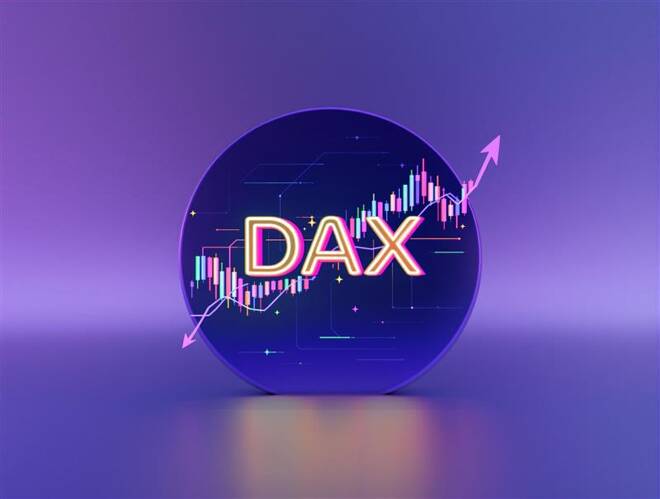Advertisement
Advertisement
Dax Index News: Forecast Hinges on Trade Breakthrough, ECB Clarity, and MAG 7 Earnings
By:
Key Points:
- DAX slumped 1.09% on July 22 as fears of a US-EU trade war resurface ahead of Trump’s August 1 tariff deadline.
- DAX outlook hinges on US-EU trade negotiations; a deal may lift the index toward its record high of 24,639.
- DAX futures are up 200 points on news of a US-Japan trade deal and potential deadline extension for China.
DAX Stumbles as Trade Deal Angst Resurfaces
EU lawmakers announced plans for retaliatory measures against the US as trade talks stalled, impacting the DAX. The DAX slid 1.09% on Tuesday, July 22, reversing Monday’s 0.08% gain to close at 24,042.
Fading hopes of a US-EU trade deal weighed on sentiment as Trump’s August 1 tariff deadline loomed. Reports of the EU planning retaliatory measures against a potential 30% levy on EU shipments raised fears of an escalation in the trade war, adding to the negative mood.
Sector Snapshot: Autos and Tech Stocks Stumble
Rising US-EU trade tensions weighed on export-linked sectors. Tech stocks Infineon Technologies tumbled 3.51%, with SAP down 1.5%.
The auto sector also came under intense selling pressure. BMW slid 1.49%, with Mercedes-Benz Group and Volkswagen dropping 1.05% and 0.92%, respectively.
Eurozone Consumer Confidence and the ECB in Focus
Eurozone consumer confidence data due Wednesday, July 23, will require consideration. Economists expect the Consumer Confidence Index to rise slightly from 15.3 in June to -15 in July. A higher-than-expected reading could signal a pickup in consumer spending, bolstering the Euro area’s economy. However, weaker sentiment could weigh on risk assets such as the DAX.
While economic data will influence risk appetite, trade developments will be crucial for market trends. Today’s figures precede the ECB’s monetary policy decision on Thursday, July 24. A lack of progress toward a trade deal leaves the EU in a policy holding pattern. Falling expectations of an ECB rate cut may pressure rate-sensitive stocks.
Wall Street Mixed as MAG7 Earnings Loom
US markets had mixed performances on Tuesday, July 22, as focus turned to the upcoming MAG7 earnings reports. The Dow and the S&P 500 climbed 0.40% and 0.06%, respectively, while the Nasdaq Composite Index dropped 0.39%.
Alphabet (GOOGL) and Tesla (TSLA) release earnings results on Wednesday, July 23.
US-EU Trade Talks Under the Spotlight
On Wednesday, July 23, US-EU trade developments will be pivotal. A trade deal could boost demand for DAX-listed stocks. Conversely, rising tensions will likely trigger a deeper sell-off.
The US and Japan reached a trade deal overnight, fueling hopes that the EU can avoid a 30% tariff, effective August 1. Notably, Japan agreed to a 15% levy on shipments to the US and to invest $550 billion into the US in return for 90% of profits.
Japan’s willingness to accept a 15% tariff could raise hopes that EU lawmakers may do the same. President Trump had previously pushed for 15-20% levies on EU goods as part of a deal.
Outlook: Key Catalysts for the DAX
The DAX’s near-term outlook depends on US-EU trade talks and central bank guidance.
- Bullish Case: A US-EU trade deal and dovish central bank rhetoric. These factors could drive the DAX toward its record high of 24,639.
- Bearish Case: Rising US-EU trade tensions or hawkish central bank chatter may push the DAX below 24,000, exposing the 50-day EMA.
At the time of writing on July 23, the DAX futures jumped 226 points, while the Nasdaq 100 was up 24 points. Futures markets signaled a positive start to the mid-week session as investors track trade developments.
DAX Technicals
Despite Tuesday’s sell-off, the DAX continues to trade above the 50-day and 200-day Exponential Moving Averages (EMA), suggesting a bullish bias.
- Upside Target: A breakout above 24,500 could enable the bulls to target the July 10 record high of 24,639. A sustained move above 24,639 may pave the way toward the 24,750 level.
- Downside risk: A break below 24,000 could bring the 50-day EMA into play.
The 14-day Relative Strength Index (RSI), at 50.95, suggests room for further gains toward 24,639 before entering overbought territory (RSI > 70).
DAX Outlook Summary: US-EU Trade Talks and Central Bank Commentary
Traders should closely track both EU-US trade headlines and central bank commentary, with trade developments likely to carry more weight.
Explore our exclusive forecasts to assess whether improving trade sentiment could lift the DAX to new highs. Refer to our latest forecasts and macro insights here for further analysis, and consult our economic calendar.
About the Author
Bob Masonauthor
With over 28 years of experience in the financial industry, Bob has worked with various global rating agencies and multinational banks. Currently he is covering currencies, commodities, alternative asset classes and global equities, focusing mostly on European and Asian markets.
Advertisement
